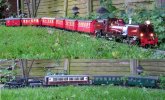duncan1_9_8_4
Garden Railway Operator
Right, 2 hours continuous running from 7am today. The two street lamps disconnected from the main line (rails). With them disconnected, I cannot for the life of me get the points to be unresponsive, or lose control of a locomotive. At 8am, I reconnected the two street lamps to the rails. Within 5 minutes the points became unresponsive while a loco was moving. Stop the locomotive, the points work again, as if somehow reseting the system. Anyway, on it went for half hour. Until I disconnected the street lights again, and guess what, all is perfect. I will of course keep an eye on it, but for now I am happy. All these problems seemingly caused by 2 little bulbs. I will find a new power source for my 2 bulbs/street lights.
And to finish off, I have put the USA trains caboose on, lights off, all good. Lights on, the same problems. Its seemingly the b@#&+y bulbs.
And to finish off, I have put the USA trains caboose on, lights off, all good. Lights on, the same problems. Its seemingly the b@#&+y bulbs.
Last edited:





